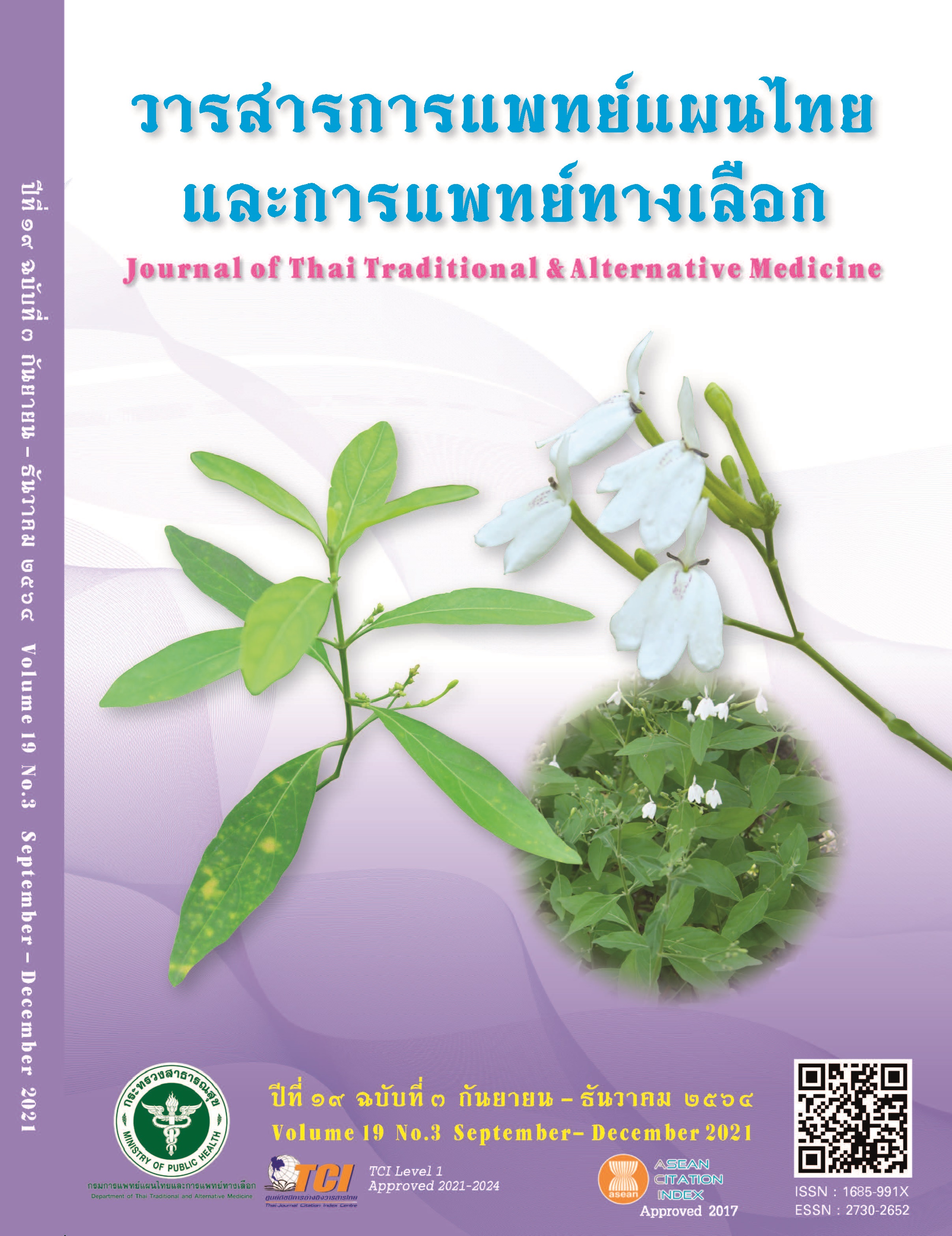Development and Validation of Miroestrol Analysis in Kwao Keur Khao Capsules Using UPLC Technique
Main Article Content
Abstract
The main active compound of Pueraria spp. (kwao kkruea khao in Thai) is miroestrol, whose content has been found to be highly variable in nature. Thus, it is necessary to control the quality of raw materials and products to ensure their efficacy and consumers’ safety. This study aimed to develop and validate a UPLC method for analysis of miroestrol in kwao khruea khao capsules. Each of the samples was extracted with ethanol and the extract obtained was cleaned up with a Sep-Pak si SPE cartridge. Miroestrol in the extract was separated on a BEH c18 (100 5 2.1 mm, 1.7 μm) column with a mobile phase composed of water and acetonitrile at a flow rate of 0.5 mL/min at detection wavelength of 214 nm. The developed method was validated according to the ICH guidelines. For miroestrol at the concentration range of 0.001–0.1 mg/g, its linearity was observed with a correlation coefficient (r) of 0.9999. The %RSDs of miroestrol content for repeatability and intermediate precision were 2.06% and 3.02%, respectively. The recovery rate of this method was 102–105%; and the limits of detection and quantification of miroestrol were 0.5 and 1 μg/g, respectively. The developed method was used for analysis of capsule products, and results showed that nine out of 22 samples contained miroestrol at concentrations of 1.40–15.68 μg/g. In conclusion, this method is suitable and can be properly used for miroestrol determination in kwao khruea khao capsules.
Article Details

This work is licensed under a Creative Commons Attribution-NonCommercial-NoDerivatives 4.0 International License.
References
Malaivijitnond S. Medical applications of phytoestrogens from the Thai herb Pueraria mirifica. Front Med. 2012;6(1):8-21.
POWO (2021). Plants of the World Online. Facilitated by the Royal Botanic Gardens, Kew. [Internet]. [cited 2021 Aug 27]. Available from: http://www.plantsoftheworldonline.org/
Lamlertkittikul S, Chandeying V. Efficacy and safety of Pueraria mirifica (Kwao Kruea Khao) for the treatment of vasomotor symptoms in perimenopausal women: phase II study. J Med Assoc Thai. 2004;87(1):33-40.
Virojchaiwong P, Suvithayasiri V, Itharat A. Comparison of Pueraria mirifica 25 and 50 mg for menopausal symptoms. Arch Gynecol Obstet. 2011;284:411-9.
Manonai J, Chittacharoen A, Theppisai U, Theppisai H. Effect of Pueraria mirifica on vaginal health. Menopause. 2007;14(5):914-24.
Suwanvesh N, Manonai J, Sophonsritsuk A, Cherdshewasart W. Comparison of Pueraria mirifica gel and conjugated equine estrogen cream effects on vaginal health in postmenopausal women. Menopause. 2017;24(2):210-5.
Chansakaow S, Ishikawa T, Seki H, Sekine K, Okada M, Chaichantipyuth C. Identification of deoxymiroestrol as the actual rejuvenating principle of “Kwao Keur”, Pueraria mirifica. The know miroestrol may be an artifact. J Nat Prod. 2000;63(2):173-5.
Shimokawa S, Kumamoto T, Ishikawa T, Takashi M, Higuchi Y, Chaichantipyuth C, Chansakaow S. Quantitative analysis of miroestrol and kwakhurin for standardization of Thai miracle herb ‘Kwao Keur’ (Pueraria mirifica) and establishment of simple isolation procedure for highly estrogenic miroestrol and deoxymiroestrol. Nat Prod Res. 2013;27:371-8
Yusakul G, Putalun W, Udomsin O, Juengwatanatrakul T, Chaichantipyuth C. Comparative analysis of the chemical constituents of two varieties of Pueraria candollei. Fitoterapia. 2011;82:203-7
Kongkaew C, Scholfield NC, Dhippayom T, Dilokthornsakul P, Saokaew S, Chaiyakunapruk N. Efficacy and safety of Pueraria candollei var. mirifica (Airy Shaw & Suvat.) Niyomdham for menopausal woman: a systematic review of clinical trials and the way forward. J Ethnophamacol. 2018;216:162-74
Lee JH, Kim JY, Cho SH, Jeong JH, Cho S, Park HJ, Baek SY. Determination of miroestrol and isomiroestrol from Pueraria mirifica (White Kwao Krua) in dietary supplements by LC-MS-MS and LC-Q-Orbitrap/MS. J Chromatogr Sci. 2017;55(3):214-21.


